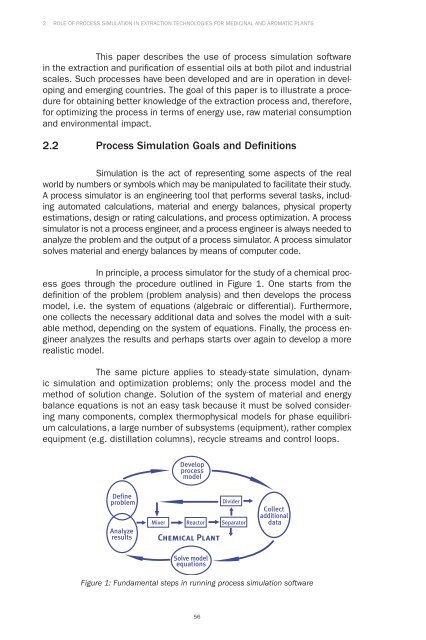Extraction Technologies For Medicinal And Aromatic Plants - Unido
Extraction Technologies For Medicinal And Aromatic Plants - Unido
Extraction Technologies For Medicinal And Aromatic Plants - Unido
You also want an ePaper? Increase the reach of your titles
YUMPU automatically turns print PDFs into web optimized ePapers that Google loves.
2 ROLE OF PROCESS SIMULATION IN EXTRACTION TECHNOLOGIES FOR MEDICINAL AND AROMATIC PLANTS<br />
This paper describes the use of process simulation software<br />
in the extraction and purifi cation of essential oils at both pilot and industrial<br />
scales. Such processes have been developed and are in operation in developing<br />
and emerging countries. The goal of this paper is to illustrate a procedure<br />
for obtaining better knowledge of the extraction process and, therefore,<br />
for optimizing the process in terms of energy use, raw material consumption<br />
and environmental impact.<br />
2.2 Process Simulation Goals and Defi nitions<br />
Simulation is the act of representing some aspects of the real<br />
world by numbers or symbols which may be manipulated to facilitate their study.<br />
A process simulator is an engineering tool that performs several tasks, including<br />
automated calculations, material and energy balances, physical property<br />
estimations, design or rating calculations, and process optimization. A process<br />
simulator is not a process engineer, and a process engineer is always needed to<br />
analyze the problem and the output of a process simulator. A process simulator<br />
solves material and energy balances by means of computer code.<br />
In principle, a process simulator for the study of a chemical process<br />
goes through the procedure outlined in Figure 1. One starts from the<br />
defi nition of the problem (problem analysis) and then develops the process<br />
model, i.e. the system of equations (algebraic or differential). Furthermore,<br />
one collects the necessary additional data and solves the model with a suitable<br />
method, depending on the system of equations. Finally, the process engineer<br />
analyzes the results and perhaps starts over again to develop a more<br />
realistic model.<br />
The same picture applies to steady-state simulation, dynamic<br />
simulation and optimization problems; only the process model and the<br />
method of solution change. Solution of the system of material and energy<br />
balance equations is not an easy task because it must be solved considering<br />
many components, complex thermophysical models for phase equilibrium<br />
calculations, a large number of subsystems (equipment), rather complex<br />
equipment (e.g. distillation columns), recycle streams and control loops.<br />
�������<br />
�������<br />
��������<br />
�������<br />
��������<br />
��������<br />
�����<br />
56<br />
�������<br />
����� ������� ���������<br />
��������������<br />
������������<br />
���������<br />
��������<br />
�����������<br />
����<br />
Figure 1: Fundamental steps in running process simulation software

















